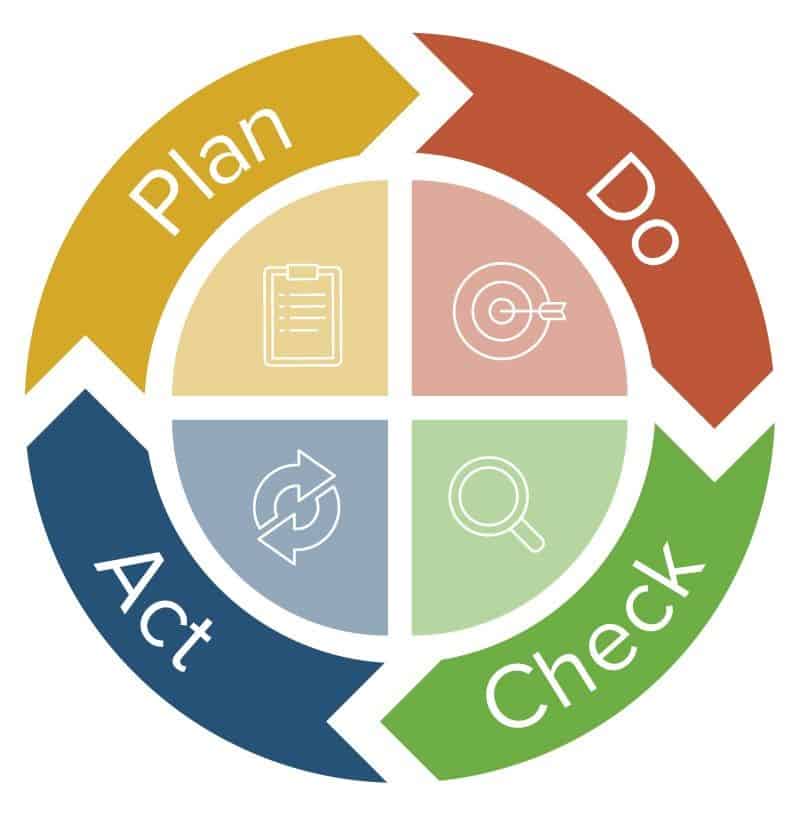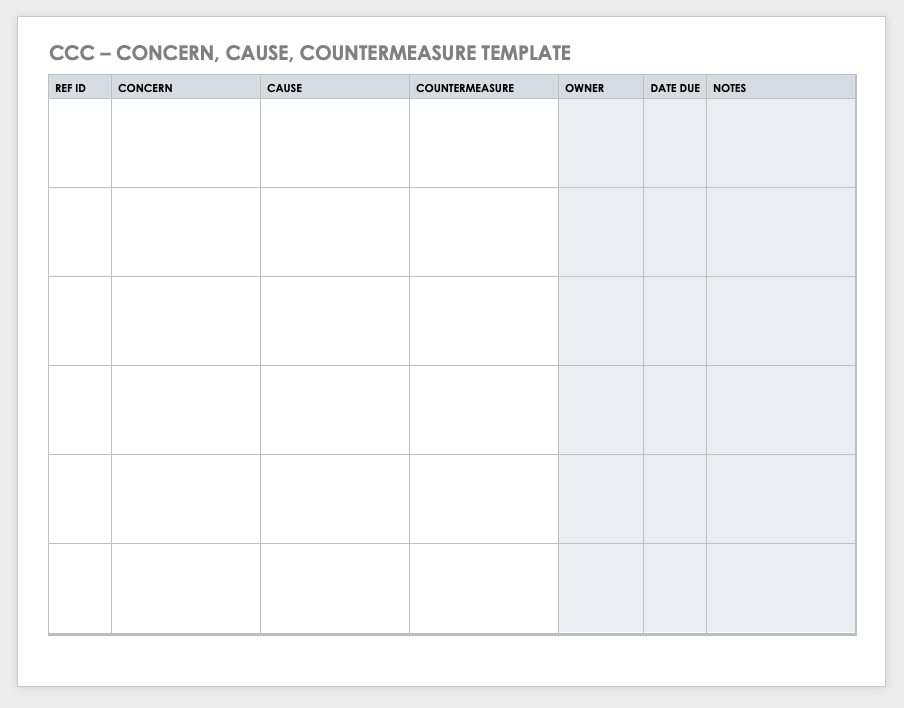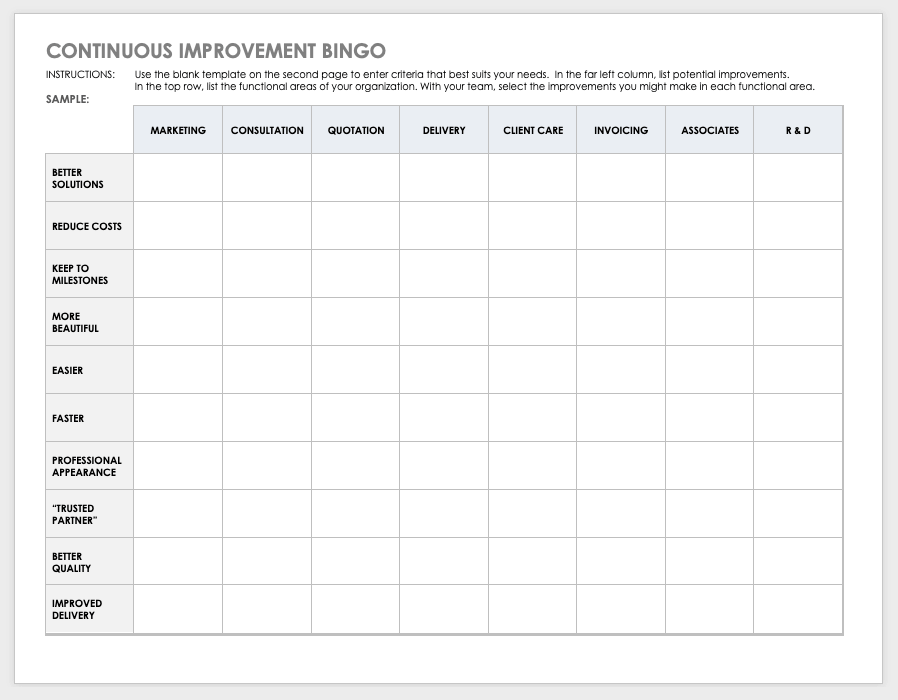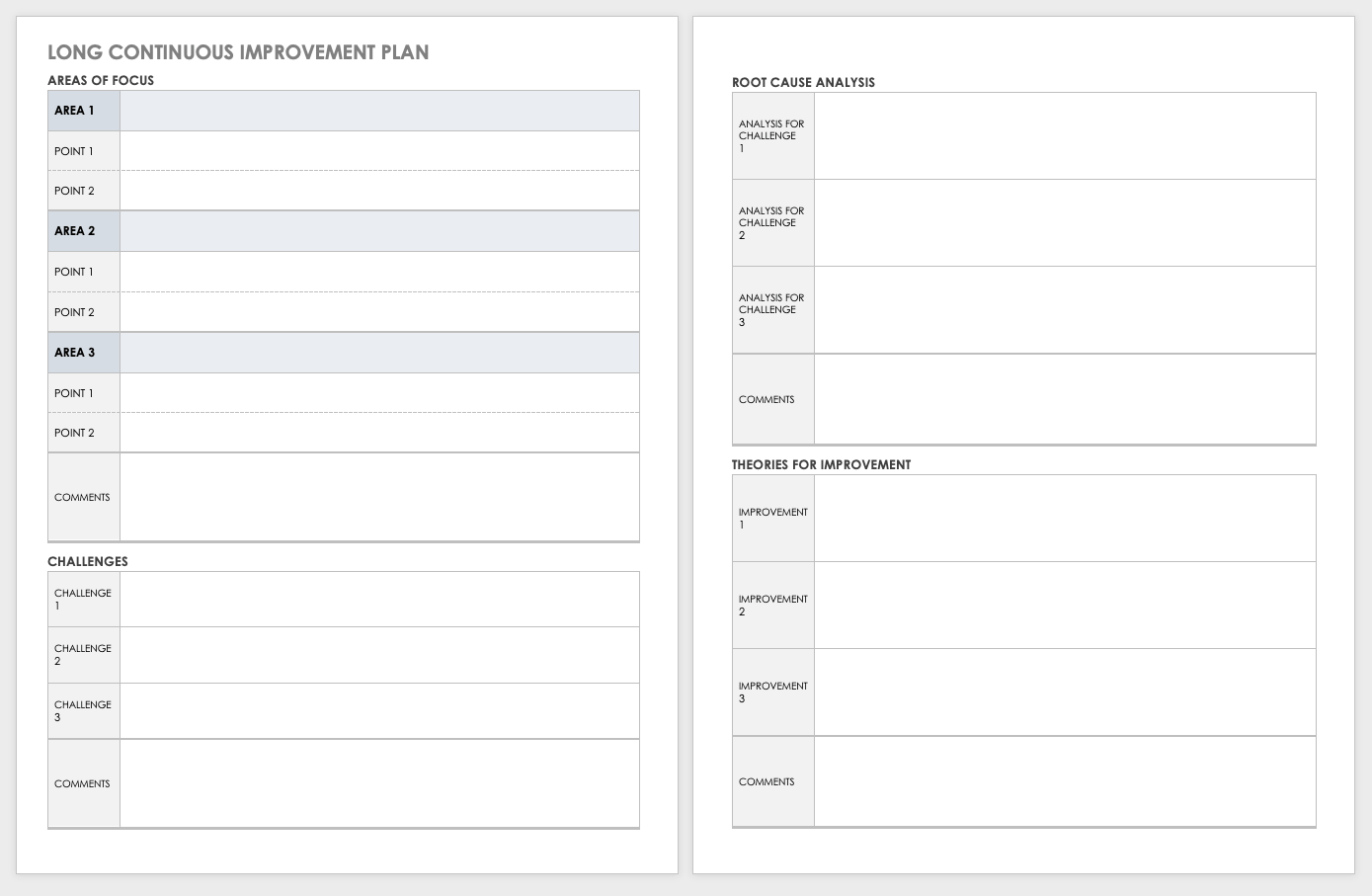What Is Continuous Improvement?
In continuous improvement (CI), teams attempt to make products and processes better by reducing waste or improving quality. The continuous improvement process can include small incremental changes over time or breakthrough changes that occur all at once.
Marshall Ariza, a Principal Consultant at Firefly Consulting, explains, “Continuous improvement is a generic term used to describe Lean, Six Sigma, and the Theory of Constraints. It’s a discipline of how to look at a situation or activity to help the people who do the work perform the tasks faster and at a higher quality, meaning with more predictable outcomes.”
Searching for problems, sketching out solutions, and iterating on improvements are at the heart of many formal methodologies — the name may change, but it’s all continuous improvement.
Ideally, entire organizations — regardless of role or department — should practice continuous improvement as part of their daily routine. With its emphasis on lowering costs and raising efficiency, continuous improvement is a pillar of Lean management and therefore, can help companies in all industries gain a competitive advantage. Continuous improvement may sound like just another generic management theory, but when done correctly, it can be powerful and transformative.
Continuous Process Improvement
Continuous process improvement (CPI) is another term for continuous improvement. Both terms describe regular efforts to change software, tools, methods, and processes. These changes can improve products, delight customers, and result in larger profits.
Continuous Process Improvement Steps
The basic continuous process improvement model includes the four steps of the PDCA cycle: plan, do, check, act. Although other improvement models have steps with different names, the PDCA activities still form the core of these improvement frameworks.
- Plan: Identify problems or a goal.
- Do: Formulate a theory or solution. Establish metrics. Implement a solution.
- Check: Track the efficacy of the solution and adjust solutions, as necessary. Watch for new problems or areas of focus.
- Act: Apply the learnings from the previous steps on a wider scale or restart the cycle to find new goals or implement improved solutions.
PDCA is a simple, repeatable system for addressing problems and testing solutions. The PDCA cycle, also known as the Deming cycle, gave root to other continuous improvement models, such as Six Sigma and the DMAIC cycle. Learn more about PDCA by reading “A Quality Principle: Everything You Need to Know about Total Quality Management.”
Continuous or Continual Improvement?
Although continuous improvement and continual improvement are sometimes used interchangeably, they have distinct meanings:
- Continual Improvement: Some quality practitioners believe that continual improvement refers to assorted efforts in different departments using a variety of methods. Not everyone who works in quality management systems recognizes the term continual.
- Continuous Improvement: The same quality pundits consider continuous improvement to refer to specific efforts within continual improvement. The ISO 9000 Technical Committee 176 debated the choice of words in the 1990s and decided against “continuous” because it implies an impossible activity wherein improvements would be made minute to minute. However, other practitioners think that continuous improvement means that everyone in an organization works toward making improvements daily. The term may also be associated with statistical process control. However, use of the term may vary by industry. For instance, ISO 14000, the environmental management standard, uses the term “continual” to refer to separate, ongoing improvement projects.
Kaizen Continuous Improvement
According to Ariza, “Continuous improvement is a take-off of Kaizen, or ‘do a little bit all the time.’ Keep making gradual improvements, reviewing them, and asking yourself every day, ‘How can we make this better?’ You will get those changes and improvements.”
As a continuous improvement approach, Kaizen helps organizations to enhance output quality, lower costs, raise morale, and empower employees. More of a philosophy than a methodology, Kaizen is less structured than Six Sigma. However, Kaizen does use visual tools such as value stream mapping and Kanban boards to track process flows. To learn more about Kaizen, read “Definitive Guide to Lean Project Management.”
Lean Continuous Improvement
Continuous improvement is a key part of Lean and Agile management. Lean methods help teams to eliminate waste and simplify workflows. Lean was first used in manufacturing, but is now used by many other industries as well.
Built on Kaizen, Lean continuous improvement shares the principles of creating big shifts from small changes and encouraging employees to offer new ideas. Lean continuous improvement creates process refinements by helping teams explore new ways of working. Learn more about this methodology by reading “The Indispensable Guide to Lean Process Improvement with Templates and Case Studies.”
Six Sigma Continuous Improvement
Six Sigma is a formal method of continuous improvement that removes variability and raises the likelihood of creating the results teams want. Most widely used in the form of Lean Six Sigma, the method uses the DMAIC cycle.
Analogous to PDCA, DMAIC stands for define, measure, analyze, improve, and control. In Six Sigma initiatives, trained Six Sigma practitioners support organizations in their data-driven improvement projects. The results-based, competitive-improvement framework for operational excellence is an offshoot of Six Sigma. The methodology uses the Continuous Improvement Maturity Model (CIMM) to gauge an organization’s progress in using Lean Six Sigma methods. Learn more about this framework by reading “Operational Excellence: Key Principles and How to Implement Them.” Six Sigma employs many of the analytical tools used in quality management, such as business process mapping, fishbone diagrams, SIPOC, and more.
Continuous Improvement Case Studies
Giles Johnston is a chartered engineer who consults with businesses to improve their operational processes, and the author of Effective SOPs. He and Firefly Consulting’s Marshall Ariza offer the following case studies of how real companies used continuous improvement processes:
- CCC Win: Johnston worked with a team who had never performed formal business process or continuous improvement work. The tool of choice: a cause, concern, and countermeasure (CCC) exercise. To begin, they sketched out their current workflow and pulled it apart. That’s a bit stupid. That doesn’t work. That only works half of the time. Only half of our customers do this. “Within a couple of hours, they had 40 legitimate concerns about their process, which they then converted into an action plan. The countermeasures became action steps in their plan,” Johnston says,
- Maintenance Walkthrough: Johnson walked through a plant with an engineer. “Just tell me everything that gets up your back,” he told the employee. He listed everything the man told him, and together they flipped the list around to draft an action plan. The engineer’s reaction: “I didn’t think it could be that easy.”
- Continuous Improvement Bingo Win: CI bingo is an ice-breaking tool to start discussions about improvement. Johnston shares an example of a team that, while playing bingo, half in jest, suggested their invoices could be prettier. When the invoices were formatted, and a logo added, the accounting team noticed that customers were paying bills faster. A quick survey of those customers revealed that customers lost the plain invoices on cluttered desks. Customers could now find the colorful sheets.
- Great Product, Poor Company Culture: Ariza describes a client whose customers said something to the effect of: We love your product, but we hate dealing with the company. “As a CEO or COO, how do you deal with that?” he asks. “That’s how continuous improvement helped. The organization could dig deeper to discover where the problem stood, whether with the approach of customer service, the voicemail setup, or something else. Frame the problem, frame the solution, and set up objectives and parameters. Then use this information for a project charter. Follow those steps for each pain point, and you end up with a series of projects to execute against.”
Additional Continuous Improvement Methodologies
Concepts similar to continuous improvement include business process improvement, which focuses on process improvement to create better deliverables, and business process management, which focuses on managing and automating processes. The following list includes other CI-based approaches that businesses and nonprofits use today:
- TQM: Total quality management (TQM) is the first methodology in the modern era to express continuous improvement principles. TQM was superseded by Six Sigma.
- Reengineering: In reengineering, organizations enact major shifts in culture and methodologies to support their principal customers.
- JIT: Just-in-time (JIT) is a foundational aspect of Kanban in which production lines obtain inventory as they consume it. For JIT to function properly, the line must remove waste, such as those found in time and processes, thereby improving quality.
- Lean Thinking: Lean thinking, also called lean management, removes unnecessary layers of management to bring all parts of an organization closer to essential activities. Use this methodology to rigorously analyze all processes and eliminate efforts that do not add value.
- ISO 9000: A quality certification standard, ISO 9000 focuses on documenting processes and, less explicitly, on improving them. The most recent version, ISO 9000-2015, includes a provision for continuous improvement.
- Theory of Constraints (TOC): This methodology analyzes processes to detect and leverage bottlenecks. Since bottlenecks will always appear, TOC provides a vehicle for implementing continuous improvement.
- Standard Work: A standard work initiative documents the best practices for all processes and tasks. It eliminates waste and adds to employee safety because all employees perform tasks in a consistent and optimal manner.
8 Principles of Continuous Improvement
The principles of continuous improvement include making small step-by-step changes, empowering employees, reflecting and repeating, and creating measurable and repeatable changes. These values apply regardless of the methods or tools you use to implement continuous improvement.
- Improvement Is Built on Small Changes: Monumental cultural shifts or game-changing research can be scary, and they aren’t necessary.
- Step-by-Step Changes Are Pocketbook-Friendly: Change doesn’t have to be expensive.
- Employee Ideas Matter: Ideas for change should come from the people who do the work daily.
- Enhancements Must Be Measurable and Repeatable: Everyone needs to know what success looks like so they can continue to see quality results.
- Focus on Improving, Not on Deploying Tools: Formal improvement methods can be helpful, but any good idea is beneficial to continuous improvement.
- Involvement Generates a Sense of Ownership: Improvements also generate gravitational pull and momentum — when teams know that management listens to their ideas, see their ideas implemented, and reap the benefits of those changes, they begin to look for ways to make changes.
- Look Within for Answers: As the saying goes, the grass is always greener on the other side — another company’s approach might seem objectively superior to your own. And while other companies’ approaches may very well work for them, remember that their organization is different from yours. It’s important to examine your own processes and find ways to improve those.
- Continuous Improvement Is Iterative: As the word “continuous” implies, to succeed over time, teams must regularly reflect on processes.
Continuous Improvement Example
What does the continuous improvement process really look like? Firefly Consulting’s Marshall Ariza offers an example from everyday home life that looks at how making small changes can have big results in efficiency and the quality of the end product.
Suppose you wake up on a Saturday morning and decide to make an omelette. Maybe you have eggs, and maybe you don’t. You rummage around in the refrigerator for onions and cheese. You look through the cabinets for a can of chilis but have to run to the basement to get a can. When you’re ready to chop vegetables, you forget where you keep the cutting board. When you’re ready to whisk the eggs, you look for the whisk in a drawer, only to find it in the dishwasher. When you’ve whisked the eggs, you realize you haven’t heated the butter in the pan. And on it goes, right to your rummaging around for the spatula to turn the omelette, and running to get a plate before the eggs burn.
Ariza explains: “You’ve been busy the whole time, but then you ask yourself: How would they do it on a cooking show on PBS? Before they start to cook, the vegetables are all cut up. All the utensils they need are in grabbing space. Looking for items and forgetting steps wastes time. So, if you compare the time from start to finish that you took to what they take on the show, you’ll see there’s a huge difference.”
“That’s what we do in continuous improvement. To start the conversation, we help people see wasted activity. Then, we help them put together a new process that takes out the guesswork and gets things systematized. Continuous improvement gets rid of the non-value added activities that don’t contribute to the desired outcome,” says Ariza.
What Is Continuous Quality Improvement (CQI)?
Continuous quality improvement is a tool that helps all members of a team work together to improve processes and products. In CQI, leaders encourage employees to share ideas, and everyone tries to make improvements daily.
In their report card on CQI, Blumenthal and Kilo referred to the CQI movement as “the effort to import into healthcare lessons that other industries learned years ago about improving product quality in order to meet their customers’ needs and expectations.”
To learn more about CQI, read “Where Data Serves People: Benefits of the Continuous Quality Improvement Approach.”
Managing Continuous Improvement
Start continuous improvement by identifying where problems usually occur. Trouble spots show up in tasks, workflows, or even workspaces. But not every problem needs an improvement program.
The pursuit of continuous improvement may be formal or adaptive: formal continuous improvement endeavors follow frameworks such as Six Sigma and recognized analysis tools to achieve measurable results. By contrast, adaptive continuous improvement uses a mix of analytical tools. In engineering and other settings, continuous process improvement regularly reviews and updates processes to align them with an organization’s evolving business goals.
Ariza describes continuous improvement efforts as two parts. “First, you learn to see what you’re dealing with and break it down into tasks that add to valued outcome versus those things you’re doing that don’t, such as rework or not using time efficiently. Second, you let the people who do those tasks make the changes. That’s what CI is at its heart. They’re the ones who understand best what’s going on. So, they are best equipped to know what will be a workable solution or what’s not very practical.”
Formal continuous improvement actions leverage methodologies such as DMAIC from Six Sigma and start from the impetus of C-level stakeholders. Some pundits believe that formal programs with measurable financial outcomes signal management’s commitment to ongoing improvement and are one way to systematize CI. When pursuing formal programs, consider teaching your team analysis techniques.
Resistance to Continuous Improvement
Despite the benefits of continuous improvement, teams sometimes shy away from the process. The thought of a full-on Agile or Six Sigma exercise, complete with statistical analysis, can intimidate managers. Employees may assume that management expects more work on top of an already full schedule.
“When you’ve been through the tunnel and have gotten to the light, you understand that you can save so much time and make life easier. Why wouldn’t you want to do continuous improvement? But if you’ve never experienced that and you’re crushed with work, it just seems like something else you have to do,” explains Johnston.
He adds that sometimes, cynicism reigns. “A lot of people feel they’ve heard it all before, with all the lofty intentions from management, and nothing happens. I sometimes see managers that tell people to do continuous improvement and then not give them any clue how to do it. They don’t have the tools or a good approach, and they don’t have the ability to coach and facilitate their staff, but they expect results. I can see a lot of people being frustrated.”
Ariza agrees. “The point is to have a goal, as opposed to just floating the idea of improvement without metrics. You need some metrics. How long to get there? How much energy and effort? What is that worth? Putting a value around projects is the contribution of Six Sigma. You prioritize projects, and define what success looks like so you can celebrate it.”
Concern, Cause, Countermeasure and CI Bingo
Johnston emphasizes how light and easy continuous improvement can be. “When most people engage with it, they realize that CI doesn’t require much effort. Just sharing a few basic tools, such as PDCA, gets a lot of results without having to train people in any methodologies. If you have a good manager who provides the appropriate thinking process, the results you can get with little output are stunning.”
One simple tool is the CCC exercise, which stands for concern, cause, and countermeasure. CCC is used in lean manufacturing and can reveal solutions without requiring complex problem solving skills. As Johnston explains, “CCC focuses on capturing people’s gripes about what’s wrong with the business. Sometimes it’s worth it just to get nagging and complaints out in the open. When that’s done, employees can look at what’s causing these issues by asking good why questions. CCC is a really fast way to create an action plan.”
Likewise, continuous improvement bingo can start the conversation about change to gather specific goals, especially when improvement requests are vague. A workshop leader lists the areas for improvement at the top and team members list possible types of improvements down the side. Then, the team matches changes to functional areas.
“What I find fascinating is the confidence it builds from taking small improvement steps,” says Johnston. “As people get more confident, what might have seemed a big step two weeks ago is now a tiny step, and people take on bigger and bigger challenges because they learn stuff, get more skills, and gain confidence. If you do it right, people get the feeling of winning and contributing to something more meaningful than just banging parts out or delivering a service. Maslow’s Hierarchy comes to mind when he says that people can do more with their minds than just delivering the service. They can contribute in other ways.”
Continuous Improvement Methodology Choices
In choosing a quality improvement methodology, consider the culture of the organization and whether improvement is already baked into its strategy. Some companies can easily systemize continuous improvement principles.
Some practitioners suggest that when small, daily changes are not possible or when the concept is new, organizations may choose rapid improvement events. Rapid improvement events last from one to five days and usually focus on one topic. Participants leave with an action plan and discrete action items. Giles Johnston’s work with CCC sheets (detailed earlier in this article) is an example of a type of continuous improvement event.
When organizations need to ensure consistent improvement efforts, the control piece in Six Sigma DMAIC may be the answer. According to Ariza, “Control is a revolutionary piece of the sequential roadmap. It’s a backstop in the improvement process that says you need metrics to measure if you’re slipping.” For this reason, and because it demands the endorsement of management and a group effort to implement quality programs, Six Sigma has largely superseded TQM and merged with Lean to offer the best of all approaches.
Further, as discussed in International Journal of Productivity and Quality Management, many CI initiatives fail because companies made insufficient effort to mesh their continuous improvement methods with their management and quality management systems.
Continuous Improvement Benefits
“With continuous improvement, you’re generally going to reduce costs. It helps eliminate rework, pinpoint and eliminate the cause of errors, and also helps you understand the dynamics of how work gets done,” says Ariza.
He explains that although you may be highly engaged in doing something, the activities may not contribute to your final result. By dissecting the activities, you can eliminate those activities that don’t contribute to a positive outcome and find ways to finish work in less time at a reduced cost. Continuous improvement offers the following benefits to help companies stay competitive in an ever-changing competitive landscape:
- Streamline workflows
- Reduce overhead
- Improve product quality
- Increase efficiency and productivity
- Decrease project costs
- Reduce waste
- Raise employee satisfaction
- Build teamwork
- Improve customer satisfaction
- Improve organizational alignment, from the front lines to the executive suite
- Increase engagement in improvement by promoting a sense of ownership and accountability for improvement
- Shorten time to share knowledge and ideas
- Raise skill level throughout a team
Continuous Improvement Tools
Continuous improvement tools help teams learn which processes to improve. The tools show teams where their strengths and weaknesses lie, and can also help keep everyone looking for and making positive changes beyond individual projects.
Use these CI tools as you embark on your continuous improvement journey:
- Benchmarking: This tool encourages you to evaluate current processes and outcomes and compare those results with competitor and industry standards for excellence.
- CCC Worksheet: Working through concerns, causes, and countermeasures provides an easy way to air complaints, identify problem sources, and determine solutions. CCC worksheets may alleviate employee fears over the complexity of a continuous improvement program. Download the CCC worksheet below.
- Business Process or Value Stream Mapping: Although process mapping software is available, teams can simply sketch their processes on paper, a flip chart, or a whiteboard. Mapping offers an easy way to gain an overview of end-to-end operations.
Then, develop and maintain quality with these tools:
- Kanban: A Kanban board helps you visualize workflow and spot bottlenecks. Use it as an initial analysis tool and then continue using it as a work management tool.
- Kaizen Event: A lean management tool, a Kaizen event is a short project, usually lasting about five days, that focuses on one area of improvement. Our Kaizen Event Checklist describes everything you need to get started.
- 5 Whys: The 5 Whys is a tool widely used in continuous improvement and quality circles. Begin by asking why a problem exists, and then ask Why? for each answer until the root cause appears. Download a 5 Whys template.
- 5S: Used originally in manufacturing and now for rapid improvement, 5S suggests the five tips that yield the most improvement: sort, set up, shine, standardize, and sustain.
- The Wastes: Originating in Kaizen and Lean Manufacturing, the three types of waste define activities that do not produce added value: muda, the process wastes; mura, the waste of unevenness; and muri, the waste of overburden. Filter your activities through the lens of the Wastes.
- RADAR Matrix: Discussed in “Quality Improvement Methodologies – PDCA Cycle, RADAR Matrix, DMAIC and DFSS,” RADAR matrix is an operational excellence tool used in the EFQM Excellence Model. The acronym RADAR stands for results, approach, deploy, assess, and refine. The tool takes the results an organization aims for, and plans and deploys approaches to attain the goals, and then assesses and iterates improvements.
- Hoshin Kanri: Translated in English as policy development, Hoshin Kanri ensures that all procedures and processes in an organization ultimately align with policies and strategies.
After improvements are made, record and monitor results with the following tools:
- A3 Reports: Lean and Agile organizations use A3 to provide an overview of lessons learned after a PDCA cycle. They usually contain context, details about the current problem, potential solutions, and a proposed plan.
- Gemba Walks: In a gemba walk, executives and management walk through a specific operational area to observe processes and learn about employee concerns. The exercise is a focus on action, not just on goals. It forces you to ask, Where do I want to go, and what needs to happen to get there?
Continuous Quality Improvement Plan
A CI plan outlines how to make products or processes better. The plan lists what the company will improve, the improvements themselves, and how to measure them. A formal plan can list the methodologies and tools the team will use to research gaps, discover solutions, and track success.
Continuous Improvement Plan Templates
Hundreds of templates exist for preparing and planning your improvement initiatives, but we’ve selected the best options to help you get started. Download the following free templates and customize them to suit your CI plan requirements.
CCC Template
Giles Johnston drafted this concern, cause, and countermeasure template. Use it as a way to break the “improvement” ice with reluctant staff or with those who have little experience with formal improvement endeavors. Pass out sheets or gather around a table to list problems and concerns, consider the root causes of issues, and brainstorm solutions.
Download CCC Template
Continuous Improvement Bingo Template
Another simple tool for starting the CI discussion, Johnston’s continuous improvement bingo card lists qualitative goals in the first column and functional areas in the top row. For each functional area, staff will suggest a goal. This template includes an example and a blank worksheet where you can add your organization’s own goals and areas for improvement.
Download Continuous Improvement Bingo Template
Long Continuous Improvement Plan Template
When your team knows where it needs to improve, the origin of problems, and potential remedies, you must capture that information in a continuous improvement plan. In this plan template, you can specify the focus area, the problem in each, the root causes, and the hypothesized solution.
Download Long Continuous Improvement Plan Template
Monitor and Manage Continuous Improvement with Real-Time Work Management in Smartsheet
Empower your people to go above and beyond with a flexible platform designed to match the needs of your team — and adapt as those needs change.
The Smartsheet platform makes it easy to plan, capture, manage, and report on work from anywhere, helping your team be more effective and get more done. Report on key metrics and get real-time visibility into work as it happens with roll-up reports, dashboards, and automated workflows built to keep your team connected and informed.
When teams have clarity into the work getting done, there’s no telling how much more they can accomplish in the same amount of time. Try Smartsheet for free, today.





